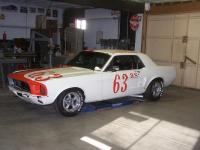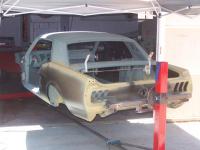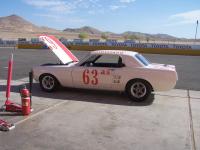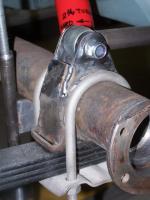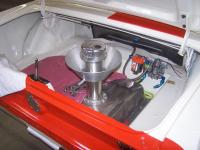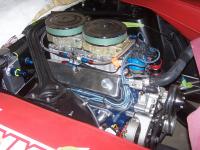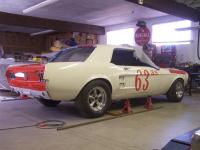-
Posts
365 -
Joined
-
Last visited
Content Type
Profiles
Forums
Events
Gallery
Everything posted by DustyMojave
-
This car is the same deal as the Terlingua Team cars. They used a total of 4 of the roughly 25 for the Team. I've just been contacted by a man who has another one of them which was owned and raced in the day by a Shelby employee named Pete Cordts. Pete's previous car was a 63 Falcon that he then re-bodied to a 64/65. It was the fastest road racing sedan in its day. As to the Terlingua Team yellow, I don't know the code offhand, but it's pretty available from the Mustang Forums. I've run across it before. IIRC, the color was suggested by a friend of Shelby's and unofficial team member. The driver who took it to the 67 Championship was the editor of Sports Car graphic Magazine, Jerry Titus. Jerry's son Rick was on a Sunbeam Tiger race team with me the following year. Rick has more recently starred on some motorsports TV shows. A tribute 67 Mustang was built for Rick several years ago. You might look that up online. I don't remember which car magazines did stories on it. Try the forums at http://forums.themustangsource.com
-
These are 1/20 scale. I was involved in Can Am racing back when these cars were racing and the models were pretty good. As he says above, they're not perfect, but not bad.
-
Here are some pics of that Javelin. It's a 1971 Javelin, built by Roger Penske Racing and driven to the 1971 Championship by Mark Donohue. It was then sold to Roy Woods Racing and driven to the 72 Championship by George Follmer. We restored this car 2x. After the 1st, the owner had parked it outdoors under a sheet of plastic and with tarps over that. Even though it was in sunny southern California, moisture trapped under the plastic destroyed the lacquer paint inside and out. We also did a more extensive restoration the 2nd time. Including repairing some crash damage inflicted in the TransAm wars in the Penske days. It had been nicely repaired, but there was 2" thick bondo in the front inner panels ahead of the wheel wells. And this 2nd time we took the car down to the bare and rebuilt it completely. This is how you go to the races! Here I am (without a beard!!) working at a race Note the big disc brakes on the NASCAR hubs on a Ford 9", the fuel filler notched into the rear spoiler, and the dual exhaust tubes (on each side)...All are correct for 1971 and 72. Paint is 1972 RWR/Follmer scheme. One member of the restoration team worked at Roy Woods Racing in the early 70s. An advisor on the restoration was Jerry Schwartz, the RWR Team manager from the time this car was with the team. Here is Roger Penske stopping by to check out the car. Rick Mears was with Roger. He announced a little later that day that he was retiring from competitive driving.
-
Here are some pics of some other similar projects I've worked on: - This is a 1969 Boss 302 that was raced in the day by a privateer. It was in pretty bad shape when we picked it up. It took quite a lot of work to get it to the state in this photo. At this point it's on the rotisserie getting the suspension mocked-up. It's been dipped and stripped and I've re-welded all the seams. It has a new cage in it (some of the welds were nearly an inch wide!) and the mock-up Boss 302 engine and the Top-loader trans are in it. Here's the new cage going together. It's 2" x .120 wall CREW which I MIG welded. The original was the same size in CREW that was stick arc welded. But it had been crudely patched at by someone who didn't know what they were doing. There were welds which were an inch wide, popcorn welds, burn through and other issues. Note that the cage is incomplete at the time of this picture. The shoulder bar and door bars are not yet in place. The taillight panel needed to be replaced and the customer wanted it to be a 70 panel like the one which was in it. But the car was originally a 69 and updated later, so later I had to replace it again to make it a 69 again. Note also the slot in the wheel tub for the rear axle over-rider traction bars like in the 67. Here's a co-worker, the late Stuart Campbell putting finishing touches on it before it's debut. In this pic, I'm between the front fenders of the Mustang and Javelin we restored at the same time. This was a Vintage Race at Palm Springs, close to 40 years after my parents met at a race there.
-
There is one "update" to the car that I entirely approve of. That is the gas tank. When the car was originally built in 1967, the SCCA rules allowed gas tanks of the size stated by the manufacturer in the "Homologation" papers. For the TransAm cars, which often had to race 250 to 300 miles long events, that was dealt with using a double-size gas tank. Shelby took 2 original Mustang gas tanks, which were not welded together, deleted the essentially flat tops, and welded the 2 bottom tubs together with one upside down on top. then a filler neck was fitted into the upper half for a filler neck which stuck out through the trunk lid with a flip top gas cap. The following season, SCCA required all racers to use "fuel cells". A "fuel cell" is a rubber or urethane bladder made with "ballistic nylon" fabric entrapped in that rubber. It's kinda like fiberglass, but the fiber is what is used for bullet-proof vests and the resin is soft like a bag. Then inside is stuffed with an open-cell foam that helps prevent sloshing and IF the bladder is punctured, the fuel will flow out of the "sponge" very slowly. That bladder is placed in a metal box to support and provide more protection. Then there is a special top with the filler neck and the fuel pickup and vent fittings and upside-down valves in the neck and those fittings. So back in 1968, the car got the original tank replaced with a fuel cell just like the NASCAR racers use and looks like a red box. That was badly rusted away and putting a new one in wouldn't look right for 1967, so we took 2 brand new replica gas tanks, cut the tops off and put them together, with a custom made bladder fitted inside, and all the other bells and whistles of a real fuel cell that looks just like the original 1967 double gas tank.
-
I wasn't there at Monterey to see how it placed and haven't heard. Since it's "Vintage Racing", the "placing" "Shouldn't matter". It's "supposed to be" all about getting the old cars out on the track and going around and sharing the history of it all. At some vintage race events, finishing positions are decided before the race starts by a drawing from a hat. But they're all still racers in race cars. If ya know what I mean...This car is not as "advanced" as some of the cars that are 5 years newer. There were advancements which were allowed by rules changes over the years. And some of the "Vintage Racers" in this good ol' boys club known as Vintage TA Racing work those rules changes into their older cars. During the restoration, there were pressures form others in the group on the owner to make many of those "updates" to this car. At one point in the process, it had fenders with beautiful flares all around, fabricated front suspension arms (not legal in TA until the tube frame/fiberglass body era), and plans for a full roll cage and a dry sump along with aluminum heads and other changes. In Vintage Racing, a lot of those involved were not there and many weren't even born when this car and its competitors were being raced. There is a great deal of "Creative Memory" in it. I lobbied for "restoring" the car to its original competition state as that is what is worth some $400K. Making all sorts of changes to update it to what it never was and out of its original condition destroys that which is of value. Anybody can take any 67 Mustang and build it with a monster engine, tubular a-arms, modern huge brakes, and all the other things that would go into a current day race car. But that is worth $30K. I've seen them sell for that a number of times in recent years. It would be like re-painting the Mona Lisa by a student of Picasso on the original canvas. I like to think that while I have not been told that my comments were why the restoration was taken back to more original condition, that I did indeed influence the outcome. As it is, the wheels are NOT American Racing Torque Thrust D Magnesium wheels. The engine makes about 100hp more than the original. And there are a number of other subtle little differences in the car.
-
This is a race car restoration project I've worked on over the last year and a half. It's a 67 mustang which was one of about 25 built by Shelby for the SCCA Trans Am race series. Like the GT350s Shelby built for the SCCA B/Production class, this had all the Shelby tricks. In 67 the Shelby team used 4 of these cars to win the Championship. The rest of the cars were sold to customers for racing. Equipped with a race prepped dual quad hi-po 289 engine, Top-loader 4-speed trans, relocated upper a-arm mounts, Monte Carlo bar, bigger disc brakes on the front from a Galaxie Wagon, Drive shaft retainer strap to keep it from falling if a u-joint failed, 9" rear axle with the customer's choice of gear ratios and Galaxie Wagon rear brakes with racing shoes, racing oversize wheel studs and nuts, an SCCA-approved roll bar, "Over-Rider" Traction Bars from the top of the axle into the interior, stripped interior with 1 fiberglass racing bucket seat and racing harness, special racing gas tank with dual electric fuel pumps with the battery in the trunk, rear fire wall, no heater or even fan, American Racing magnesium Torque Thrust D Wheels, Goodyear racing tires, racing headers and straight dump pipes ending in front of the rear tires, front license plate recess cut out for an oil cooler, window retainer straps, hood pins, brake cooling ducts, racing springs, Koni double-adjustable racing shocks, fire extinguisher, aluminum plates where the headlights go, racing wire harness, Tach and Oil Pressure gauges set in an aluminum dash insert, No speedo, aluminum switch box on the center tunnel behind the shifter, etc. They left Shelby's Culver City California factory truly ready to race except for numbers and fuel. The car is owned again by its original owner Fred Sutherland. He had bought it new from Shelby for about $4,000. It's now worth in the neighborhood of 100x that. He won some races and set some lap records with it. While working on the car, I ran across a race program from an SCCA race at Willow Springs in 1969. In the back there is a list of lap records for the track. For the A/ Sedan Class which is the over 2-liter class for Trans Am cars, Fred held the lap record with this car. That is in spite of the fact that the Shelby team and many others used this track for practice. Just before ordering this car, Fred had won the regional Championship for B/Production with his 289 Cobra. The engine was rebuilt by Dave Dralle who successfully raced Cobras in the 60s and is considered still to be one of the best with Cobras and Mustangs. It dynoed at 487hp, which is about 17hp more than the Bud Moore Mustang Boss 302s achieved in their Championship year of 1970. This was a full rotisserie rebuild. The car had wound up in the south parked outdoors with some serious rust before being re-acquired by Fred for us to restore. The 3rd photo is from the 1st test session at Willow Springs with John Morton driving.
-
The Edsel I believe was built originally by Bill Stroppe in the late 60s when an Edsel was considered a piece of junk. At one offroad race at Barstow, the 1980 Fireworks 250, The start of the race followed the wedding of one Louise Van Trese (sp?) and Butch Gilliland. They were both veteran offroad racers and the Edsel was under the ownership of Louise who had been racing with her dad. They wore driver's suits for the wedding with white lace on her suit and his looked like a black Tux. The service was held at the Start/Finish line with the help of the race promoter. At the conclusion of the wedding, they donned helmets and got into the Edsel to start the race. When I lapped them later in the race in my unlimited class buggy seen in the avatar, they honked their horn and gave big waves. I think they were enjoying themselves. The class the Edsel was raced in was for production autos from VW Bugs to the Edsel, to a Chevy Nova, Camaro, Pinto, AMC Pacer, Datsun 510, a couple of very successful Saabs and even a 55 Chevy (later rebodied as a 57) and a Falcon Ranchero. After a while, the VW Bugs were banned because nothing could compete with them. The Edsel won some races after that. It was competitive in the class for quite a few years.
-
Edwards is north of my home and El Mirage is east. Muroc IS named after the Corum Brothers of Rosamund of about 100 years ago. The Air Force changed the name of the dry lake from Muroc to Rogers after a pilot who crashed there (IIRC). Edwards was a test pilot who crashed a Northrop Flying Wing bomber prototype in the late 40s.
-
Well I'm not next to the Spruce Goose, but I can see El Mirage from my kitchen window. Been there a Zillion times. Dry lakes racing with SCTA, dirt bikes, offroad buggies and even land yachts. Until the Bureau of Land Management put a fence around the 19,000 acres and started charging $20 admission, my buddies and I used to ride our dirt bikes and buggies to there across the desert from our homes. Now we go around the outside of the BLM fence. Me in the Kelly & Hall belly tank a few years ago The Basso, Klos, and Kong streamliner with a Wes Cooper/Kong Jackson built, Ray Basso owned Ford Flathead V8 (me standing the other side of the canopy) Gliders are launched south of my home next to the San Gabriel Mountains from the Crystalaire Glider Port. They are more safely towed aloft by small planes. Rides are available for a fee (last I heard it was $60).
-
Since I was unsuccessfully seeking my bottle of Tenax Thursday night, and had not gone back to what I was doing...This thread was very timely for me. But such other chemicals are over 20 miles away from here, so the shipped deal may work out better for me. Have any of you run into any restrictions re shipping of hazardous chemicals?
-
Derr..This has an in and out box. It's not a clutch link, it's a shift link for the in & out. And I meant to say carbs, not throttle. Beautifulk work Curt.
-
Looking awesome Curt! Nice job on the small details like brake lines and throttle and clutch linkage.
-
In my offroad race car seen in my avatar, I never had nor wanted any gauges. I felt there was no time to be looking at gauges. Huge warning lights let me know if there was something serious. Many 2-seat offroad racers have the guy in the right seat watch gauges, but I also felt they add substantially to complexity of the wiring, which increases the number of things that can go wrong and the likelihood of it happening along with increasing the complexity of diagnosing a problem out in the middle of the desert and difficulty repairing it. In a small circle track car, gauges add a lot to complexity, and many drivers won't ever look at them. When I drove a vintage V8-60 car for testing, the procedure to start the engine was to buckle in, pump up the fuel tank watching the gauge (3 psi) and put it in gear while the push truck lined up. Then as the push truck got it rolling, watch the oil pressure gauge. When the oil pressure jumped up, open the fuel valve and flip the kill switch to run and kick the throttle to give it some fuel. When it started, give it some throttle to pull away from the push truck, give the fuel pump a couple of pumps and go! I never looked at the tach or other gauges while driving. Many cars have a mechanical fuel pump to take over once it's running, but many did not. If no mechanical pump and the engine starts sputtering, you probably forgot to pump up the pressure that lap, so ya better pump fast and furious to keep the engine running. There is no starter or battery to restart the engine if you stall it. So that those who are not familiar with these things can understand, the chrome deal on the left outside of the cockpit is the hand fuel pump. It actually is NOT a fuel pump. It is an air pump. The driver uses it to pump air into the top of the fuel tank to push fuel into the carbs or on later cars, fuel injection. The pump is really just like a short manual tire pump.
-
What gauges are found in a race car depends greatly on who owns it and who drives it. for instance... V8-60 Kurtis No gauges. Another famous and highly successful Kurtis-Offy (Eddie Meyer) This had: - fuel pressure off the fuel pump at the back of the left cam box - and a fuel shutoff valve on the left upper dash - Water Temp off the back of the top of the block - Oil Pressure off the back of the block - Oil Temp off the right side of the block - Tach off the back of the right cam box - And an ignition kill switch off the magneto And yeah...I know there are a bunch of things about this car that are historically wrong. Like blue anodized machined aluminum plug wire holders and stainless braided lines with pretty anodized aluminum fittings. Although those aren't so bad as much of the plumbing on this car had been aircraft grade stuff. But most of the hoses should have had black rubber cover over the stainless. I'd like to point out that the Offy engine is a little different from many production car engines and this affects correct detailing. - The crankcase is 2-piece cast aluminum, upper and lower split at the crank centerline. The lower half is the oil pan. - The cylinder block is cast iron and includes the cylinder head, so the floor of the valley around the spark plugs is iron. - The cam boxes are aluminum castings with separate covers. - The cam drive gears are housed in a cast aluminum housing on the front of the engine and extending up to the cam covers. - In the Offy of this era, there are no rubber boots on the plug wires. Note that on this engine, the block is painted krinkle black. There are aluminum sleeves around the spark plugs which stand up above the top of the block a little. The cam blocks and covers are polished. This is fairly common, but many had the cam blocks rough as sand cast finish. The crankcase and cam drive housing are also typically as sand cast finish. I have never seen an Offy with the aluminum parts of the engine painted. That doesn't mean that it couldn't have been or never was done. But if it was, it certainly wasn't very often, especially on the West Coast.
-
Oh...And the rear axle doesn't move up and down. It stays with the frame, which the spare tire support frame is attached to. The Corvette had independent rear suspension from the 63 year model on. GS Vettes were built to represent 63 year model Vettes (even if they never had the divider bar in the rear window).
-
Its sturdily mounted to the spare tire support. The battery was moved there for weight balance. This is common in road racing cars as well as drag racing door slammers.
-
Brake lines do NOT run along the top of the beam and under the steering box as shown here. They would go from the front of the master cylinder which is on the front side of the panel forward of the pedals, and go direct to the sides to tabs standing up at the edge of the floor pan where they become flex lines with black rubber cover out to the back side of the brake backing plates. There is no Tee in the front lines. 3 lines connect to the Master cylinder: one to the right front, one to the left front, and one along the left side of the tunnel to the rear. There is a tee on the frame next to the left front of the trans.
-
Plasticine, huh? Going Gumby on us. Is styrene strip hard to get in Alaska? And are you going to use putty over the clay? I'd be worried about the clay continuing to emit oily residue which would affect paint later.
-
Well Dan, You 2 got together the same year as my wife and I. Same age too. Except for me...I'm a punk kid only 56. I suppose if we can hang on a little longer, we might make this a permanent deal, huh?
-
I always thought you had to start with a 1275 to qualify a Mini for the term "Sports"... I see a pair of SU carbs on the left. A sports car acquaintance of the British persuasion used to refer to them as "Stupid Useless". But he had a few less social versions of the acronym as well... He preferred Webers. I'd have to agree on that. How is it you Aussies look like brothers???? You, Rob above and my brother-in-law Bruce from WA...All look the same. ????
-

The rest of the Cobra collection.
DustyMojave replied to cobraman's topic in General Automotive Talk (Trucks and Cars)
A Cobraphile huh? I can appreciate that. In 1962 Carroll Shelby took my dad for a ride around Riverside Raceway in the prototype Cobra. At the time it was painted pearl metallic yellow. It got painted a number of different colors and taken to different places to give the impression that there were already a number of Cobras built. I'm currently working on restoring a 67 Shelby TransAm race Mustang to be used in Vintage Racing such as the Monterey Historics which the car is invited to for this year. The Featured Marque this year will be Shelby. Not a Cobra, but related... -
I LOVE that brake linkage. Like was said above, I would convert to juice brakes for my own. I have for some friends on their hotrods. But you did an awesome job of scratchbuilding that! Simple, yet looks VERY scale. As to your inspirational video that's a fellow my dad worked for some 60 years ago. Dad had never told me that he worked for Isky. But one time in the late 70s, he and I went to another cam maker's shop. Norris Cams in Van Nuys, California, about a mile from where my mom grew up and lives today, to get a new cam for the Baja Bug you see in my signature. The owner, Norris Baronian enthusiastically greeted my dad as a long-lost pal he hadn't seen for many years. They talked for a couple of hours about the old days when they worked together at Isky and all their old pals in common. I'm really not sure now if they worked there before my dad joined the Air Force in '48, or after he got out in '51. An old friend of mine, Wes Cooper talked about going to the dry lakes for the 1st time (for him) when he was 12 years old. it was 1927 and he and his mom were out for a weekend drive. They lived in Glendale and were in what is now Santa Clarita. They stopped at the Solemint Store for gas. There was a group of "gow jobs and hot irons" (Wes' words in telling me the story) that pulled up for the same purpose. The cars excited Wes. They were on their way to El Mirage Dry Lake (about 10 miles east of where I live and visible out my kitchen window, Muroc Lake that Isky talks about is about 20 miles north of my house, but not visible due to the higher ground in between) for a speed competition. Wes' mom decided they could go along and see what it was about. Wes told me he figured his mom had NO idea how far out into the desert they were going. Wes wound up passing away at an SCTA meet at El Mirage in the mid 1990s with a time slip in his hand for the 34 Ford coupe he was a partner in and engine builder for (Cooper, Donovan and Creel..."Donovan" as in Donovan racing engine blocks and cylinder heads). His partner, Roy Creel had just upped the record in their class for flathead engined coupe by 12mph on that run (HUGE increase). Wes and buddy Ray Basso were in Ray's pickup truck down the side of the course doing "Patrol" duty and Wes had fallen asleep and was napping. He died in his sleep of heart failure. He had never stopped going to the lakes events for nearly 70 years except when they were shut down by WWII.
-
Yeah, Halibrand wheels were used on LOTS of race cars, including the GS Vettes. That "Cobra" pattern of Halibrand wheels got used on Eisert Formula A road race open wheel cars, Lola-Chevy Can Am cars, Ford GT40s, lots of Sprint cars, a number of Indy cars, etc.

